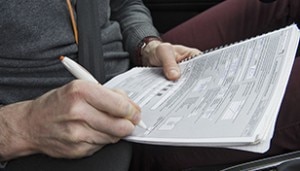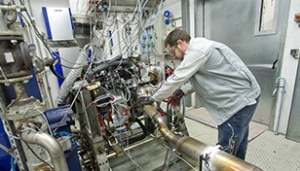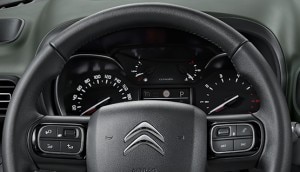NEW APPROVALS

The Worldwide Harmonised Vehicle Test Procedure (WLTP) will be used for vehicle type approval in the European Union. It introduces a new test cycle and a new procedure for measuring fuel consumption, CO2 emissions and regulated pollutants for vehicles under standard (laboratory) conditions.
It will gradually replace NEDC*.
Thanks to sound technological choices made in anticipation of the regulations, Citroën is ready for this new WLTP approval protocol, mandatory for all passenger vehicles from September 2018.
*New European Driving Cycle
THE WLTP TEST
The Worldwide Harmonised Vehicle Test Procedure (WLTP) will be used for vehicle type approval in the European Union. It introduces a new test cycle and a new procedure for measuring fuel consumption, CO2 emissions and regulated pollutants for light vehicles* under standard (laboratory) conditions.
The WLTP will become mandatory for all new passenger cars on 1 September 2018 and a year later for new light commercial vehicles.
* Passenger vehicles and light commercial vehicles of up 3.5 tonnes
FROM NEDC TO WLTP
One of the WLTP’s purposes is to more accurately reflect real driving conditions and the technologies with which vehicles are equipped during the approval process.
It sets out stricter test conditions and more dynamic driving conditions than the previous NEDC cycle dating back to the 1990s. It was designed using actual driving data, whereas the NEDC was based on theoretical driving profiles.
The WLTP also produces more precise data because it takes into account the specifications of each vehicle, including any and all optional equipment, which can have a significant impact on fuel consumption and CO2 emissions.
SPECIFICITIES OF THE WLTP
•Speed
WLTP tests are performed at higher speeds: 46.5 km/h on average (compared to 34 km/h for the NEDC cycle).
•Distance
The duration of the WLTP test cycle is longer : 23.25km (instead of 11km for NEDC)
•Cycle time
The duration of the WLTP test cycle is longer : 30 mn (instead of 20 mn for NEDC)
•Driving
The WLTP cycle is more dynamic. There are more acceleration and braking. The driving behavior and situations are more realistic.
•Equipment
Additional features (which can differ per car) are taken into account.
CITROËN AND WLTP
 Thanks to sound technological choices made in anticipation of the regulations (SCR in diesel and GPF in petrol), Citroën is perfectly ready for the new WLTP approval protocol which more closely mirrors customers’ actual use.
Thanks to sound technological choices made in anticipation of the regulations (SCR in diesel and GPF in petrol), Citroën is perfectly ready for the new WLTP approval protocol which more closely mirrors customers’ actual use.
In addition, to better inform its customers, Citroën publishes the consumption data of its models on its website since 2016 and the NOx emissions data since March 2018 in real driving conditions, based on a protocol developed with NGOs (T&E and FNE) and certified by an independent third party (Bureau Veritas).
Customers can also set up their car and usage parameters to check consumption under their own use.
TIMETABLE FOR IMPLEMENTATION
 From September 2017: WLTP will officially apply to new types of cars
From September 2017: WLTP will officially apply to new types of cars
• All new types of cars (vehicles models that are introduced on the market for the first time) are tested to WLTP
• Cars type approved using NEDC before September 2017 can still be sold
From September 2018: WLTP will apply to ALL new car registrations
• All new cars must be tested according to the WLTP test and no longer on NEDC
• An exception will be made for end of series vehicles to allow for a limited number of unsold vehicles in stock that where approved under the old NEDC test to be sold
From January 2019:
• All cars in dealerships should have WLTP-CO2 values only
REAL DRIVING EMISSIONS
From September 2018, in addition to the WLTP protocol, the manufacturers will have to measure the emissions in Real Driving Situation (RDE) of all their vehicles sold within the European Union, as well as in Switzerland, Turkey, Norway, Liechtenstein , Israel and Ireland.
Citroën performs this type of test using a PEMS system.
ON-ROAD REAL DRIVING EMISSIONS
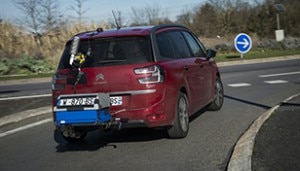 A car equipped with a Portable Emissions Measurement System (PEMS) is driven on public road. The PEMS collects data to verify that the legislative caps for pollutants are not exceeded. It provides complete real-time monitoring of major pollutants emitted by vehicles (NOx, PN).
A car equipped with a Portable Emissions Measurement System (PEMS) is driven on public road. The PEMS collects data to verify that the legislative caps for pollutants are not exceeded. It provides complete real-time monitoring of major pollutants emitted by vehicles (NOx, PN).
The collected data are analyzed to verify that the driving conditions fulfill RDE requirements and that emissions are within acceptable limits.
GLOSSARY
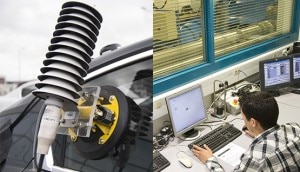
•Bureau Veritas
Bureau Veritas is a global inspection, certification and laboratory testing company.
Groupe PSA has initiated a unique and scientific approach in order to guarantee reliable information to its customers. This initiative has been deployed in collaboration with two leading NGOs T&E, Transport and Environment, and FNE, France Nature Environnement – committed to the environment and sustainable mobility and a certification body, Bureau Veritas.
• Euro 6
European emission standards define the acceptable limits for exhaust emissions of new vehicles sold in EU and EEA member states. The emission standards are defined in a series of European Union directives staging the progressive introduction of increasingly stringent standards. This is a set of increasingly stringent standards for new vehicles.
Euro 6 is the current standard. It defines maximum emission values for fine particles and nitrogen oxides lower than the previous Euro 5 standard.
From September 2018, the Euro 6 standard enters a second stage: the Euro 6.2 standard (Euro 6.d-TEMP). It requires limits even lower than the previous stage in terms of fine particle emissions for vehicles equipped with petrol engines.
• FAP : Filtre A Particules (Particulate Filter)
The particulate filter features a porous silicon carbide core to trap pollutant particles in the exhaust gases. It then burns and destroys them periodically.
The filter regeneration system is managed by a control unit that also carries out self-diagnosis. The particulate filter enhances the benefits of HDi technology in environmental protection, vehicles equipped with HDi diesel engines and the filter have near-zero particulate emissions.
• France Nature Environnement
French federation of nature and environmental protection associations
• NEDC : New European Driving Cycle
The NEDC is a driving cycle, last updated in 1997, designed to assess the emission levels of car engines and fuel economy in passenger cars (which excludes light trucks and commercial vehicles).
No longer representative of the current use of vehicles, it is gradually being replaced by WLTP (Worldwide harmonized Light vehicles Test Procedures ) from September 2018.
• PEMS : Portable Emissions Measurement System
Embedded on vehicle, this emission measurement system analyzes the entire flow of exhaust gases.
• RDE : Real Driving Emissions
The Real Driving Emission (RDE) will complement the WLTP, measuring pollutant such as NOx and particles emissions in number (PN), emitted by the car while driven on the road.
RDE ensures that cars deliver low emissions compared to laboratory tests, which is a significant leap in tests of cars emissions.
A car equipped with a Portable Emissions Measurement System (PEMS) is driven on public road and allows the measurements.
• SCR : Selective Catalytic Reduction
A pioneer in the field of clean engines, the PSA Group has designed and developed an original technology to treat nitrogen oxide emissions. Selective catalytic reduction (SCR) eliminates the nitrogen oxide (NOx) emitted by diesel engines. The SCR technology allows 90% reduction in NOx emissions and from 2% to 4% reduction in CO2 emissions.
• Transport & Environment
European environmental association specialised in establishing a sustainable transport policy.
• WLTP : Worldwide Harmonized Light Vehicles Test Procedure
It’s a new test procedure that gives a more realistic overview of vehicle fuel consumption and CO2 emissions that will be legally binding for all vehicles as of September 2018. WLTP will replace step-by-step the previously applicable New European Driving Cycle (NEDC) testing procedure.
Q&A
• What is an approval procedure?
It is a standardised set of parameters, including the test cycle, used for vehicle approvals. Having a single approval procedure makes it possible to compare the fuel consumption and CO2 emissions of different vehicles. The NEDC (New European Driving Cycle) has been in force since 1992. It will be replaced by the WLTP for all vehicle types from September 2018.
• Why change the approval procedure?
The former NEDC procedure was deemed unrepresentative of how our customers actually their vehicles. The fuel consumption data we disclose going forward, measured with the WLTP, will be closer to the actual consumption levels observed by our customers.
• The new procedure takes into account the weight of the equipment, which was not the case before. How is that done?
The weight of equipment is actually taken into account in the levels CO2 emissions determined via the WLTP. This is a regulatory requirement. Our networks and our brands’ websites will have a tool to determine CO2 emissions depending on our customers’ choices in terms of vehicle configuration and equipment.
• What are the differences in consumption between the former NEDC test cycle and the WLTP?
The reported WLTP consumption amounts exceed the amounts measured in the NEDC by approximately 25% to 30%. The impact of the driving cycle depends directly on the displacement of the engine. Big cars have a smaller gap than small cars.
• Will my fuel consumption increase with the WLTP?
There will be no impact on your car’s consumption with the new WLTP values. The WLTP will only result in a higher CO2 g/km value for the same vehicle than under the NEDC because it is a more rigorous and longer test, meaning simply that the WLTP better reflects the actual situation. In other words, the higher CO2 value does not mean an increase in fuel consumption, but rather a more realistic CO2 measurement due to the change in the way vehicles are tested.
• When do you plan to release all of the new CO2 values?
The regulations require that CO2 values be displayed according to the WLTP measurements from 1 January 2019.
